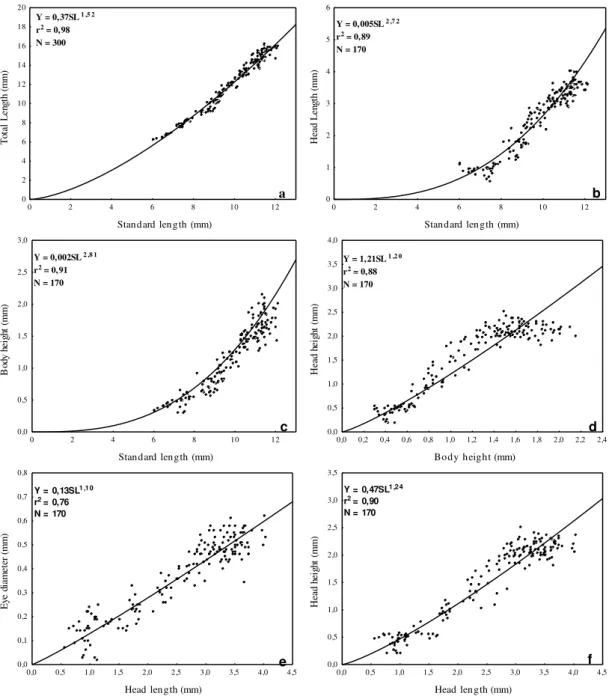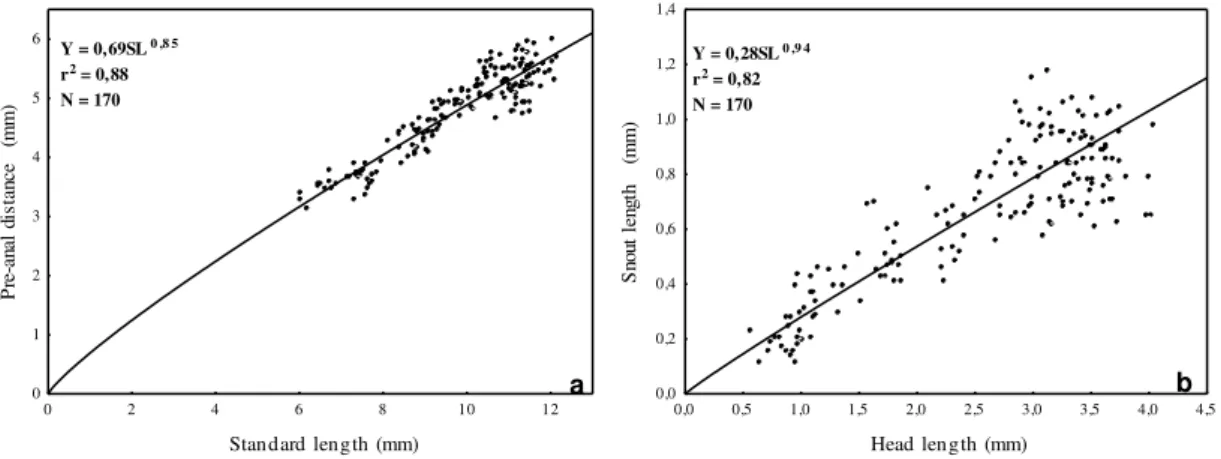Allometric growth patterns in hatchery-reared larvae of the catfish
Lophiosilurus
alexandri
(Pisces: Pseudopimelodidae)
[Padrões de crescimento alométrico em larvas criadas em cativeiro do pacamã
Lophiosilurus alexandri (Pisces: Pseudopimelodidae)]
R.J. Guimarães-Cruz1, V.C. Veloso-Júnior1, N.G. Sales1,3, D.A.A. Oliveira2, J.E. Santos1,3*
1Programa de Pós-graduação PUC Minas Belo Horizonte, MG
2Escola de Veterinária Universidade Federal de Minas Gerais Belo Horizonte, MG 3PUC Minas (MEC/SESu) Belo Horizonte, MG
ABSTRACT
The aim of the present study was to characterize the relationships that occur between morphometric variables of larvae of Lophiosilurus alexandri Steindachner, 1876 through their allometric growth analysis. Total length, head length and body height were correlated with standard length, head height and body height, as well as eye diameter and head height with head length. The results revealed allometric positive relation during the initial development, where the b coefficient varied between 1.10 and 2.81. The variable pre-anal distance in relation to the standard length and the snout length in relation to the head length revealed an allometric negative relation, where the b coefficient was 0.85 and 0.94, respectively.
Keywords: initial development, morphometric study, pacamã
RESUMO
O objetivo do presente estudo foi caracterizar os tipos de relações que ocorrem entre as variáveis morfométricas das larvas de Lophiosilurus alexandri Steindachner, 1876, por meio da análise de seu crescimento alométrico. As variáveis comprimento total, comprimento da cabeça e altura do corpo foram correlacionadas com o comprimento padrão; a altura da cabeça com a altura do corpo; e o diâmetro do olho e a altura da cabeça com o comprimento da cabeça. Os resultados revelaram relações alométricas positivas durante o desenvolvimento inicial, quando o coeficiente b variou entre 1,10 e 2,81. A variável distância pré-anal em relação ao comprimento padrão e a variável comprimento do focinho em relação ao comprimento da cabeça revelaram relação alométrica negativa quando o coeficiente b foi 0,85 e 0,94, respectivamente.
Palavras-chave: desenvolvimento inicial, estudo morfométrico, pacamã
INTRODUCTION
Analyses of morphometric measurements allow comparisons of different developmental stages between species, and with other morphologic characteristics, they are useful in species identification (Sanches et al., 1999).
Lophiosilurus alexandri Steindachner, 1876 reproduces in captivity, has high commercial
value in the Brazilian State of Minas Gerais (Sato et al., 2003) and has a great potential for aquaculture (Bazzoli and Godinho, 1997). According to Sato et al. (1987) this species is close to extinction in the upstream region of the Três Marias reservoir in Minas Gerais.
survivor of the larvae of these species regarding stocking densities and the tolerance to different salinities were already determined (López and Sampaio, 2000; Luz and Santos, 2008). Moreover, the growth in different luminosity conditions and types of food, and the early development stages of the species are described in literature (Tenório et al., 2006; Guimarães-Cruz et al., 2009).
The importance of the knowledge about the characteristics of its initial development was mainly due to its economic potential, considering its importance in fishing at the São Francisco and Doce rivers basins, and also for aquaculture and preservation of this species, since its fishing is predatory and the alterations and elimination of its natural habitat are reducing the natural stocks. Thus, the allometric growth patterns were studied with the aim to characterize the relationships that occur between morphometric variables of L. alexandri larvae.
Therefore, this study may provide morphometric data that can be useful for the taxonomy, aquaculture and conservation of this species.
MATERIAL AND METHODS
In the larviculture laboratory of the Hydrobiology and Hatchery Station at Três Marias –
CODEVASF, nearly 300 newly hatched larvae originating from a natural spawning were placed in a container (0.43m2 bottom area) with flowing water. Ten specimens were collected every 24h from hatching (day 1) until day 30 post-hatching. Larvae were anaesthetized with ethylenglycolmonophenylether (Merck, 0.2 –
0.5mL L-1) (Koumoundorous et al., 1999) and fixed in 2% buffered-formaldehyde solution for 24 h. From day 7 onward the larvae were fed daily with rotifers and cladoceran.
At the moment of collection the physical/ chemical parameters of the water were registered with a Horiba multi-analyzer: temperature (23.99±1.80°C), pH (6.40±0.27), electric conductivity (60.50±4.86µS cm-1) and dissolved
oxygen (4.11±0.82mg L-1), which were considered adequate for larval development.
Using a stereoscopic microscope, the specimens were used to obtain morphometric data: total length, standard length, snout length, eye diameter, head length, head height, body height and pre-anal distance, using a digital paquimeter (precision 0.01mm), on the specimens collected from the day 1 to day 30.
For the analysis of corporal relations, the morphometric variables of total length, head length, body height and pre-anal distance were related to the standard length. The head height variable was related to the body height. The snout length, eye diameter and head height variables were related to the head length during development. To verify the type of relation between the variables, the allometric growth analysis (Fuiman, 1983) was used. To determine the intercept, the coefficient of growth of the potential equation and r2 value were used in the linear regression with data transformed into the base of natural logarithms, using standard length, body height and head length as independent variables, as the effected analysis. To determine the type of growth, the growth coefficients were compared statistically through the T test (p<0.05). When b=1, the growth was isometric. The growth was allometric positive when b>1 and allometric negative when b< 1.
RESULTS AND DISCUSSION
0 2 4 6 8 10 12
Standard length (mm)
0 2 4 6 8 10 12 14 16 18 20 T ot al L en gt h (m m )
Y = 0,37SL 1 ,5 2
r2 = 0,98
N = 300
a
0 2 4 6 8 10 12
Standard length (mm)
0 1 2 3 4 5 6 H ea d L en gt h (m m )
Y = 0,005SL 2 ,7 2
r2 = 0,89
N = 170
b
0 2 4 6 8 10 12
Standard length (mm)
0,0 0,5 1,0 1,5 2,0 2,5 3,0 B od y he ig ht ( m m ) c
Y = 0,002SL 2 ,8 1
r2 = 0,91
N = 170
0,0 0,2 0,4 0,6 0,8 1,0 1,2 1,4 1,6 1,8 2,0 2,2 2,4
Body height (mm)
0,0 0,5 1,0 1,5 2,0 2,5 3,0 3,5 4,0 H ea d he ig ht ( m m )
Y = 1,21SL 1 ,2 0
r2 = 0,88
N = 170
d
0,0 0,5 1,0 1,5 2,0 2,5 3,0 3,5 4,0 4,5
Head length (mm)
0,0 0,1 0,2 0,3 0,4 0,5 0,6 0,7 0,8 E ye d ia m et er ( m m )
Y = 0,13SL 1 ,1 0
r2 = 0,76
N = 170
e
0,0 0,5 1,0 1,5 2,0 2,5 3,0 3,5 4,0 4,5
Head length (mm)
0,0 0,5 1,0 1,5 2,0 2,5 3,0 3,5 H ea d he ig ht ( m m )
Y = 0,47SL 1 ,2 4
r2 = 0,90
N = 170
f
Figure 1. Positive allometric relations between the morphometric registered variables for L. alexandri
larvae regarding standard length (a, b and c), body height (d) and head length (e, f).
The present study characterized the types of relationships that occur between morphometric variables L. alexandri larvae through its allometric growth. Important morphometrical alterations responsible for the transformation of the larval body shape into the juvenile form
the standard length, for body height and pre-anal distance, from the first to the twentieth day. In addition, in Bryconamericus stramineus
(Eigenmann, 1908) (Characidae), the snout length, eye diameter and head height variables in relation to the head length, as well as the pre-anal distance, body height and head variables, in relation to the standard length showed positive allometric growth (Galuch et al., 2003). In L. alexandri the variables were also related to the head length and the standard length, however, pre-anal distance and the snout length revealed negative alometrical growth. This negative alometrical growth of the snout length may be related to the fact that the species undergo a
much accentuated metamorphosis, mainly in the more advanced developmental stages, when its dorsally-ventrally flattened body is more evident as shown in figure 3b. The positive allometry of the variable related to the head (head length, head height and eye diameter) during the larval development indicates continuous cerebral development, possibly allowing the improvement of the motor and sensorial ability. The total length and body height variables showed positive allometry, while the pre-anal distance variable presented negative allometry. This possibly evidences a standard growth of the trunk, different from the other segments of the body.
0 2 4 6 8 10 12
Standard length (mm)
0 1 2 3 4 5 6
P
re
-a
na
l
di
st
an
ce
(
m
m
)
Y = 0,69SL 0 ,8 5
r2 = 0,88
N = 170
a
0,0 0,5 1,0 1,5 2,0 2,5 3,0 3,5 4,0 4,5
Head length (mm)
0,0 0,2 0,4 0,6 0,8 1,0 1,2 1,4
S
no
ut
l
en
gt
h
(
m
m
)
Y = 0,28SL 0 ,9 4
r2 = 0,82
N = 170
b
Figure 2. Negative allometric relations between the registered morphometric variables for L. alexandri
larvae regarding standard length (a) and head length (b).
CONCLUSIONS
The results found in the present study showed that L. alexandri larvae undergo major changes in their body structures during their initial development, which are related to their adaptability and survival in the environment.
ACKNOWLEDGEMENTS
The authors wish to thank the PROBIC PUC Minas, FAPEMIG for financial support project and CODEVASF for the assistance during the collection of the fishes.
REFERENCES
BAZZOLI, N.; GODINHO, H.P. Ovócitos vitelogênicos do surubim Pseudoplatystoma coruscans e do pacamã Lophiosilurus alexandri. In: MIRANDA, M.O.T. (Org.). Surubim. Belo Horizonte: IBAMA, 1997. p.81-96.
FUIMAN,L.A. Growth gradients in fish larvae.
J. Fish Biol., v.23, p.117-123, 1983.
GALUCH, A.V.; SUIBERTO, M.R.; NAKATANI, K.
GUIMARÃES-CRUZ, R.J.; SANTOS, J.E.; SATO,Y.et al.Early development stages of the catfish Lophiosilurus alexandri Steindachner, 1877 (Pisces: Pseudopimelodidae) from the São Francisco River basin, Brazil. J. Appl. Ichthyol., v.25, p.321-327, 2009.
KOUMOUNDOUROS, G.; DIVANACH, P.; KENTOURI, M. Osteological development of the vertebral columm and of the Caudal complex in Dentex dentex. J. Fish Biol., v.54, p.424-436, 1999.
LÓPEZ,C.M.; SAMPAIO,E.V. Sobrevivência e crescimento larval do pacamã Lophiosilurus alexandri Steindachner, 1876 (Siluriformes, Pimelodidae), em função de três densidades de estocagem em laboratório. Acta Sci., v.22, p.491-494, 2000.
LUZ, R.K.; SANTOS, J.C.E. Avaliação da tolerância de larvas do pacamã Lophiosilurus alexandri Steindachner, 1877 (Pisces: Siluriformes) a diferentes salinidades. Acta Sci., v.30, p.345-350, 2008.
OSSE,J.W.M.;VANDENBOOGAART,J.G.M. Fish larvae, development, allometric growth, and the aquatic environment. ICES Mar. Sci. Symp., v.201, p.21-34,1995.
OSSE, J.W.M.; VAN DEN BOOGAART,
J.G.M.; VAN SNIK, G.M.J. et al. Priorities during early growth of fish larvae. Aquaculture, v.155, p.249-258, 1997.
RUSSO, T.; COSTA, C.; CATAUDELLA, S. Correspondence between shape and feeding habit changes throughout ontogeny of gilthead sea bream Sparus aurata L., 1758. J. Fish Biol., v.71, p.629-656, 2007.
SANCHES, P.V.; NAKATANI, K.; BIALETZKI, A. Morphological description of the developmental stages of Parauchenipterus galeatus (Linnaeus, 1766) (Siluriformes, Auchenipteridae) on the floodplain of the upper Paraná river. Rev. Bras. Biol., v.59, p.429-438, 1999.
SATO, Y.; CARDOSO, E.L.; AMORIN, J.C.
Peixes das lagoas marginais do rio São Francisco a montante da represa de Três Marias, Minas Gerais. Brasília: Câmara dos Deputados, 1987. 42p.
SATO, Y.; FENERICH-VERANI, N.;
GODINHOH.P.Reprodução induzida de peixes da bacia do São Francisco. In: GODINHO,H.P.; GODINHO, A.L. (Org.). Águas, peixes e pescadores do São Francisco das Minas Gerais. Belo Horizonte: PUC Minas, 2003. 468p. TENÓRIO,R.A.;SANTOS,A.J.G.;LOPESJ.P.
et al. Crescimento do niquim (Lophiosilurus alexandri Steindachner, 1876), em diferentes condições de luminosidade e tipos de alimento.

